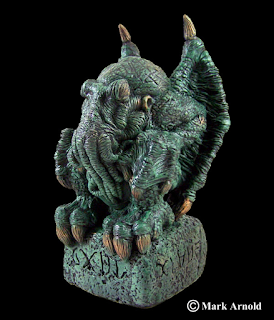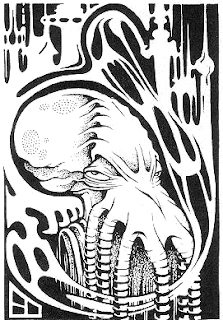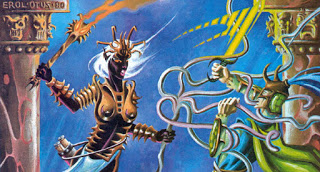The very early history of Gary Gygax’s World of Greyhawk Fantasy Setting had more than a few mentions of H.P. Lovecraft’s “Cthulhu Mythos.” Michael Falconer put the problem neatly on the (now-defunct) Pied Piper Publishing message boards:
Surely some influences [of fantasy literature] are greater than others. Barsoom, for example, is not integrated into Greyhawk; one must actually leave Greyhawk and travel to Barsoom for a Barsoom-like experience. A ‘Cthulhu’, on the other hand, can (and does) easily exist in Greyhawk, quite comfortably using as his pawns Giants straight out of Pratt’s The Roaring Trumpet, who use as their lackeys some of Tolkien’s Orcs. And so on. An understanding of Greyhawk therefore depends on a familiarity with the most famous fantasy works of at least Poul Anderson, Robert E. Howard, Fritz Leiber, H.P. Lovecraft, A. Merritt, Michael Moorcock, Fletcher Pratt, J.R.R. Tolkien, and Jack Vance. Then, of course, there’s Greek, Norse, Finnish, and Celtic mythology; The Bible and extra-biblical Christian legendry; and fairy tales… (emphasis added)
Robert J. Kuntz, who was to be Gygax’s co-DM in the original Greyhawk campaign, confirms this and adds (again from the late lamented PPP message boards):
Greyhawk had specialty priests. The Elder Priests (for the Cthulhu gods) I designed; EGG worked on those for the pantheons, and we had Pholtus early on, with extra blinding light spells and their particular trappings. Again, as many, many facets of the game were advancing all at once, each component received “boosts” when we thought of these, but there was little time at that point to get too specialized with parts, as this was a broad approach and very time consuming.
RJK even mentioned a specific locale associated with such things, although apparently it was only barely explored by the players in the original campaign:
The castle was but a few miles NE of the City as we pictured it, though we never then drew an environs map for it, but we knew where it was, as we knew where the Temple to the Latter Day Old Ones was, about half way to the Castle along the same path from the city, and beneath ground, also accessible by the sewers, which I later drew. … Jim Ward’s and my bro’s PCs both entered the secret Temple, but by the stump, not the sewers. Eric Shook’s PC entered the sewers but never made it to the Temple.
Of course the first edition of the 1st Edition AD&D book Deities and Demigods famously included both the Cthulhu and Melnibonean mythoi, but they were preemptively withdrawn in subsequent printings because of fears that Chaosium (which at the time had acquired the rights to both, and turned them into RPGs) might raise a legal fuss.
But there were, of course, more Lovecraftian Things scuttling about in the wilds of Greyhawk.
First, there is the obscure god Dalt, “The forgotten lesser god of portals and enclosures” who gave the archmage Mordenkainen the Silver Key of Portals, as Mordenkainen’s Fantastic Adventure tells us. However, RJK gives us a bit of additional flavor that puts the lost god in a Lovecraftian perspective (from Dragonsfoot):
On Fomahault, an OD&D style Greyhawk addie I wrote back in 1975 for the campaign–and this is where the Lovecraftian Mythos stuff was mainly infiltrating from into the campaign– the Priest of Leng held “The Silver Key”. Dalt is a real god, but renamed and in disguise, and it is these two threads which I brought together to supply Mordenkainen with the Key.
So, no, he never found it in the campaign, as it was already written into parts we were DMing, but it did exist, as did Dalt.
Once the Lovecraftian connection is made with the “god of portals”, one thing immediately jumps to my mind; Nyarlathotep, the messenger of the Outer Gods with a thousand forms. Acting as a sort of herald for the Outer Gods really seems to fit with what little we know about Dalt (excepting his later retconning as being Vatun’s brother or something, which seems really to be plucked out of thin air to make connections for connections’ sake).
Yog-Sothoth might work as an inspiration for Dalt, too. It is known as “the opener of the way” after all…
Finally, I would be remiss if I didn’t point out the Lovecraftian nature of the Elder Elemental God, who has taken up a fair share of posts here on the blog over the years. Again, setting aside the retconning that tries to make the EEG just a part of Tharizdun, the fact that the Elder Elemental God was described by Gygax as “being imprisoned on a distant star” lays its Lovecraftian origin clear from the outset. The association with madness and tentacles (tentacle rods held by the priests, tentacle curtains in the temples, etc.) I think makes the Lovecraftian nature of the EEG plain.
Tharizdun himself does have some Lovecraftian elements, to be sure (big evil god sleeping/imprisoned) but it’s fair to say that’s a fairly common trope within Greyhawk, and we see it in several different places (Tharizdun, Zuggtmoy, Elder Elemental God, the pit fiend in the Drachensgrab mountains, etc.).












See this post for a bit of Lovecraft history in D&D.
http://zenopusarchives.blogspot.com.au/2013/01/the-cthulhu-mythos-in-d-in-1970s.html
I love Lovecraft and have over the years added more Lovecraftian-elements to various games I have played (D&D, WitchCraft, Buffy). But never specifically to Greyhawk ones.
Though I do have a player in my current Greyhawk-based 5e game asking for more Lovecraftian themes. My own preference is for more "Clark Ashton Smith" ones, but interestingly enough that is where the Tharizdun/Thasaidon connection comes back in.
You do see this more in the later (4e/5e) editions of D&D. D&D 5, in particular, puts Tharizdun on equal footing of Cthulhu.
Now how to creatively add them both to a world mythos? That is likely another long post by you or I.
Trivia: The D&DG actually said that the Cthulhu Mythos appeared by permission of Chaosium. But one of the Blume brothers was bothered by having a “rival” company’s name in a TSR’s book.
Only in the second edition. In the first edition there was no credit, and from the third onwards Cthulhu and Stormbringer myths were removed.
Lots of HPL-related content in RJK's El Raja Key Archive @ http://www.tlbgames.com/collections/archive and Rob also detailed the history of the Mythos in Greyhawk in his article "Advent of the Elder Ones: Mythos vs. Man in the Lake Geneva Original Campaign, 1973-1976 by Robert J Kuntz" in AFS#2 @ http://hallsoftizunthane.blogspot.com/2012/12/afs-issue-2-is-released.html (alas, currently OOP).
Allan.
A scholarly and insightful post. Article like this one are what you do best, and a great service to lovers of the Greyhawk world.
A great post, thank you.